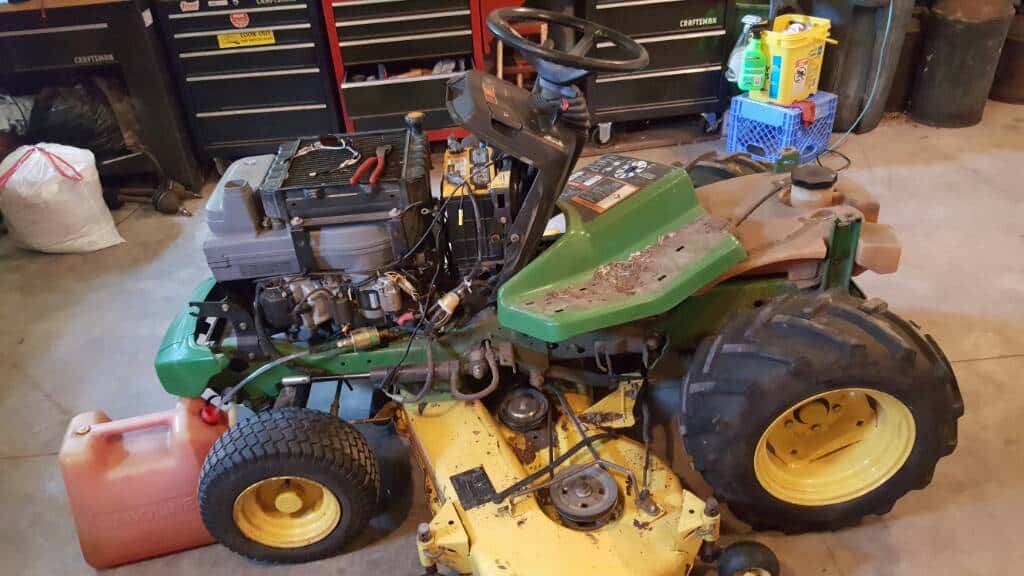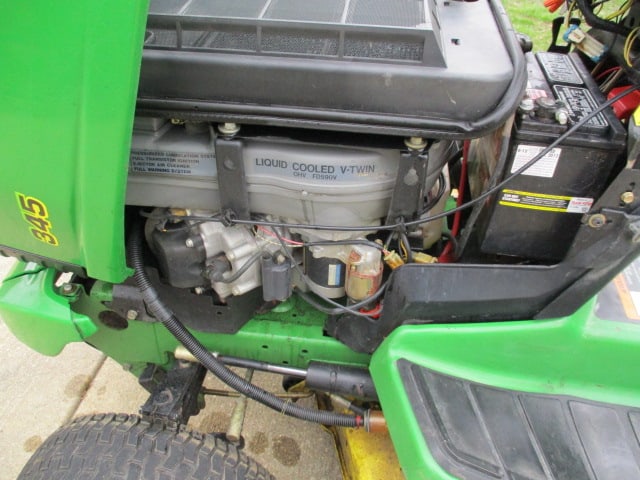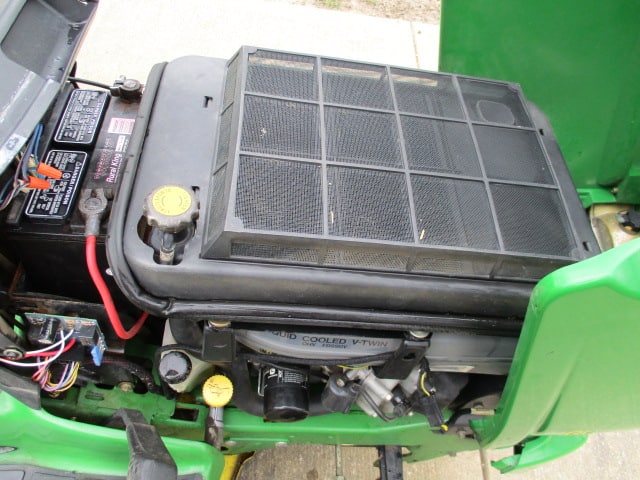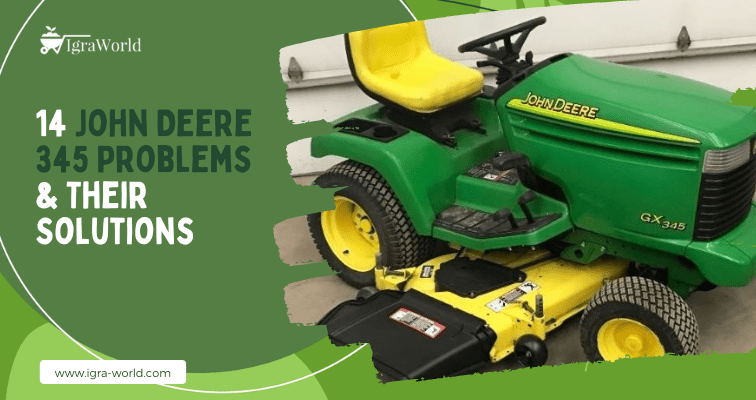The John Deere 345 lawn tractor—part of the esteemed 300 series and produced between 1995 to 2001—boasts a powerful Kawasaki FD590V engine and is renowned for its durability and cutting-edge features. Whether you’re considering purchasing this model or already own one and are facing some hitches, it’s essential to be aware of potential issues.
So, let’s delve into the most common problems, uncover their causes, and explore how you can troubleshoot them!
Igra-World’s team, with decades of hands-on experience in lawn tractor mechanics, has compiled this guide based on frequent customer queries and feedback. One customer, Mark Thompson, once told us, “I wish I had this guide when I first got my JD 345—it would’ve saved me so much time!”
How to Troubleshoot Most Common Issues:
- Ignition module malfunctions causing starting issues. (severity: high). How to fix: Replace the faulty ignition module or consult a professional.
- Engine overheating due to clogged cooling fins. (severity: medium). How to fix: Regularly clean the cooling fins and ensure proper airflow.
- Fuel pump issues leading to engine cut-outs. (severity: high). How to fix: Check and replace the fuel pump if necessary.
- Faulty voltage regulator causing battery drainage.* (severity: medium)*. How to fix: Inspect the voltage regulator and replace if defective.
- Uneven mowing due to misaligned cutting deck.* (severity: low)*. How to fix: Adjust the cutting deck to the correct height and alignment.
- Transmission slipping or not engaging properly. (severity: medium). How to fix: Check transmission fluid levels and ensure proper maintenance.

1. Ignition Module Malfunctions
The most common culprits causing ignition module malfunctions are a failing ignition module, issues with the time delay module, and potential grounding problems.
The 45, equipped with a 1.5 L Yanmar 3TNM72 or 3TNV88 diesel engine boasting 20 horsepower, also experiences a malfunctioning of ignition module. This module is pivotal—it provides the spark that ignites the fuel in the engine. Without it functioning correctly, your tractor won’t start!
The engine’s specifications, such as its 78 mm bore and 77 mm stroke, emphasize its power, but even such a robust engine can be rendered useless if the ignition module fails. It’s not just about getting the tractor moving; it’s about ensuring that the power and efficiency of the engine are not compromised. Ignition problems can lead to reduced engine power, inconsistent performance, and even potential damage to other components if not addressed promptly.
How to Fix Ignition Module Malfunctions:
- First and foremost, ensure your battery is fully charged and connections are clean and tight.
- Check the freshness of the gas in the tank.
- Examine the spark plugs—clean them and check the gap.
- If you’re still facing problems, consider testing the ignition module. Use a multimeter to check continuity and resistance. Ensure all points flow and replace the module if any locations show an open circuit or high resistance.
- For those with expertise, consider checking the time delay module—known to give John Deere 345 owners some trouble.
- Grounding issues have been reported. Ensure the ground wire from the battery to the engine is functioning correctly. A bad ground can fry components on the circuit board.
- If you’re not comfortable with these steps or if the problem persists, seek professional assistance!

2. Engine Overheating
The most common culprits causing engine overheating are clogged cooling fins, engine overload, incorrect carburetor fuel mixture, and improper ignition timing.
Poduced from 1995 to 2001, is a robust lawn tractor known for its reliability. Yet, like any lawn tractor, it can face issues. Engine overheating can be attributed to several factors. The 18HP Kawasaki 585cc engine, with its liquid-cooling system, requires consistent airflow to maintain optimal temperatures. Clogged cooling fins can restrict this airflow, leading to overheating.
Additionally, the tractor’s power can be misused, causing engine overload—especially if it’s pushing beyond its 5.5 mph forward speed or 2.5 mph reverse speed. Incorrect ignition timing can lead to excessive cylinder head temperatures. And remember, the carburetor’s fuel mixture—if too lean—can elevate engine temperatures. Addressing these problems is crucial—not just for the tractor’s longevity but for the safety of the operator and the efficiency of tasks like mowing with its 54-inch mower deck.
How to Fix Engine Overheating:
- Check the oil level—add oil if necessary.
- Reduce the load on the engine if it’s being overworked.
- Clean clogged cooling fins to ensure proper airflow.
- Adjust the carburetor fuel mixture if it’s too lean.
- Set the ignition timing correctly to prevent hot spark plugs.
- Ensure the valves are set properly for adequate air intake and exhaust gas discharge.
- Keep an eye on the tractor’s speed—don’t push it beyond its limits!
- Regularly inspect the cooling system for any blockages or leaks.
- Always ensure the mower blades are sharp and balanced—dull blades can strain the engine!

3. Fuel Pump Issues
The most common culprits causing fuel pump problems are contaminated fuel, wear and tear due to age, and insufficient maintenance—specifically, not replacing the fuel filter regularly.
The 345, a garden tractor, often faces challenges with its fuel system, especially the fuel pump. When the fuel pump malfunctions, it can lead to engine stalling—particularly during high-demand situations or at full throttle. Difficulty in starting the tractor, engine misfires, reduced power, and even fuel leakage are other symptoms you might encounter.
The fuel pump is crucial, ensuring the engine receives a consistent fuel supply for optimal performance. Given the tractor’s 18.5 horsepower and its liquid-cooled V-twin design, maintaining a steady fuel flow is essential for harnessing its full power. A malfunctioning fuel pump can compromise the tractor’s ability to effectively utilize its hydrostatic transmission and its 4.4-gallon fuel tank capacity.
How to Fix Fuel Pump Issues:
- Check Fuel Pressure: Use a fuel pressure gauge to measure the pump’s output. Ensure the readings align with the manufacturer’s specifications.
- Inspect for Leaks: Examine the fuel lines and connections. Replace any damaged parts immediately.
- Test Fuel Pump Relay: This relay controls the fuel pump’s power supply. Make sure it’s functioning correctly.
- Clean or Replace Fuel Filter: A clogged filter can strain the fuel pump. Ensure it’s clean or replace it if necessary.
- Inspect Fuel Lines: Ensure there are no blockages and that they’re properly connected.
- Check Fuel Tank Vent: A blocked vent can impede fuel flow. Clean or replace it if needed.
- Replace the Fuel Pump: If all else fails, it might be time to replace the fuel pump. Ensure you choose a compatible pump, disconnect the battery, access the old pump, and carefully replace it with the new one. Test the new pump’s functionality before wrapping up!
4. Faulty Voltage Regulator
The most common culprits causing a faulty voltage regulator are wear and tear over time, grungy terminal blocks, and potential issues within the charging circuit of the voltage regulator.
The 345 even with its 18HP Kawasaki 585cc 2-cyl gasoline engine and hydrostatic transmission, also experiences a faulty voltage regulator which can lead to battery drainage, affecting the mower’s performance. The voltage regulator, essential for maintaining the battery’s charge, can become defective due to prolonged use. Grungy terminal blocks at the regulator can also hinder proper connection.
Furthermore, the charging indicator circuit within the regulator can malfunction, even if the system appears to be charging. It’s crucial to address these issues promptly. A malfunctioning voltage regulator can lead to other complications—like the mower not starting or the battery light staying on, even when the battery is fully charged. Ensuring the voltage regulator functions correctly is vital for the mower’s longevity and your peace of mind!
How to Fix Faulty Voltage Regulator:
- First, check if the battery is being charged using a basic multimeter.
- Inspect the terminal block at the regulator. Clean if grungy.
- If the battery light is ON, it doesn’t necessarily mean it isn’t charging. Check with a meter—run at wide open throttle. You should get between 13.5 to 14.5 volts dc.
- If the system is charging but the battery light remains on, the charge indicator circuit within the voltage regulator might be defective.
- Consider replacing the voltage regulator if issues persist. Remember, quality matters—avoid cheap aftermarket items!
- Always ensure the voltage regulator is mounted correctly, especially if it needs grounding or cooling.
5. Uneven Mowing
The most common culprits causing uneven mowing are misaligned cutting decks, dull or damaged blades, and issues with the mower deck’s spindles or pulleys.
One of the prevalent issues is uneven mowing which can be a result of various mechanical issues. A misaligned cutting deck is often the primary reason. But, the mower’s blades play a crucial role too—dull or damaged blades can lead to inconsistent cuts. The mower deck’s spindles, which help in blade rotation, can wear out or get damaged, affecting the mowing pattern.
Additionally, the pulleys, which drive the belts and blades, can become misaligned or wear out. Given the tractor’s power and weight, uneven mowing can lead to soil compaction in certain areas, affecting grass health. It’s essential to address these issues promptly to ensure your lawn remains healthy and aesthetically pleasing!
How to Fix Uneven Mowing:
- Adjust the cutting deck to ensure it’s at the correct height and alignment.
- Check the blades—sharpen or replace them if dull or damaged.
- Inspect the mower deck’s spindles and pulleys for wear or damage.
- Ensure all components are tightly secured.
- Test the mower on a flat surface to confirm the issue is resolved. If not, consider seeking professional help!
6. Transmission Slipping or Not Engaging Properly
The most common culprits causing transmission slipping in the 345 are low transmission fluid, worn-out components in the Tuff Torq K70 transmission, and potential leaks at the split line between the upper and lower case of the transmission.
The 345’s Tuff Torq K70 transmission, a key component of this tractor, can sometimes face issues—especially with age. Leaks can develop at the split line between the upper and lower case, leading to a drop in fluid levels. This can cause the transmission to slip or not engage properly.
Additionally, the tractor’s weight—around 699 lbs—combined with continuous use, can put strain on the transmission. It’s crucial to address these issues promptly. Not only does it affect the tractor’s performance, but it can also lead to more significant, costly damages. Remember, a well-maintained transmission ensures that your lawn tractor runs smoothly, and efficiently, and lasts longer!
How to Fix Transmission Slipping or Not Engaging Properly:
- First, check the transmission fluid levels. If low, refill with the recommended fluid.
- Inspect the Tuff Torq K70 transmission for any visible leaks, especially at the split line.
- If leaks are found, consider resealing the casings. This might require some expertise—so if you’re unsure, seek professional help!
- Ensure that the drive belt and idlers are in good condition. Replace if worn out.
- If the issue persists, consider consulting with a specialist or checking online forums for more specific guidance.
If you don’t already own one, should you buy it?
The 345 model has been a staple in the lawn tractor world, known for its durability and cutting-edge features. However, like any machine, it’s not without its issues. Some users have reported problems like ignition module malfunctions, engine overheating, and fuel pump issues. But, on the flip side, many have praised its robustness and reliability. For instance, a user from TractorByNet mentioned that this model is a well-built machine and has been quite reliable, with only the ignition module failing in its lifetime. Another user highlighted the tractor’s power steering and the efficiency of its 54-inch deck.
But, before you make a purchase, it’s essential to consider the age and maintenance history of the tractor. If you’re looking at a well-maintained model, the mower could be a worthy investment. However, if you’re wary of potential issues, you might want to consider alternatives—like a model from Kubota, which is often praised for its durability and efficiency.
If you’re after a reliable lawn tractor and are prepared to address potential hitches—many of which are fixable—this could be a solid choice. But always weigh the pros and cons, and perhaps even consult current users or forums for more insights.
Why trust Igra World?
At Igra World, we dove deep—researching and identifying the most common issues with the 345. Our team, collaborating closely with seasoned mechanics, spent countless hours diagnosing and testing each problem. Through meticulous documenting and analyzing, we’ve crafted a troubleshooting guide that not only resolves specific issues but also recommends preventive measures. We believe—in our professional opinion—that this model lawn tractor stands out in its class. It’s a testament to our commitment (and passion) to ensuring lawn tractor owners get the best out of their machines.
